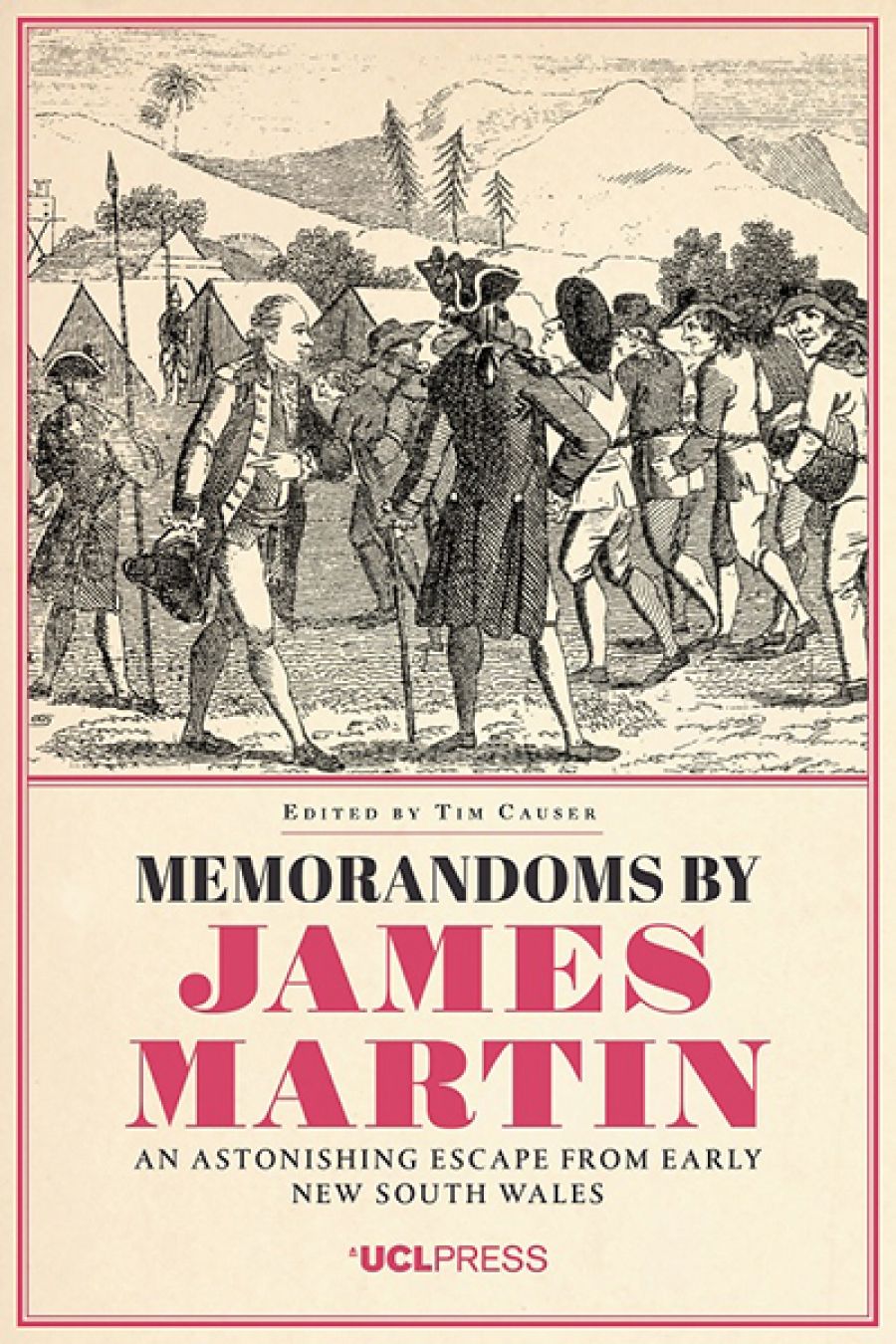
- Free Article: No
- Contents Category: History
- Custom Article Title: James Dunk reviews 'Memorandoms by James Martin: An astonishing escape from early New South Wales' edited by Tim Causer
- Review Article: Yes
- Online Only: No
- Custom Highlight Text:
In 1784 William Bryant was sentenced, rather optimistically, to be transported to the American colonies. Britain had just lost the War of Independence; Bryant thus languished in a hulk in Portsmouth while Britain adjusted to the loss. This meant that when he finally arrived in New South Wales with the First Fleet, Bryant’s ...
- Book 1 Title: Memorandoms by James Martin
- Book 1 Subtitle: An astonishing escape from early New South Wales
- Book 1 Biblio: UCL Press, £17.99 pb, 203 pp, 9781911576822
The escapees took the fishing boat, notwithstanding the colony’s food crisis, and with two infants, a little pork, and a hundredweight of flour and rice, made their way up the eastern coast of the continent. They were often chased away by Aborigines when they sought to land for food, water, and shelter. Pursued by Torres Strait Islanders, they fled across the Timor Sea, skirted West Timor, and landed in Kupang, where they were received as free people.
The party were soon recognised, and returned to England, although four adults and both children died en route. There, the survivors were treated mercifully both by the courts and by the press. No one in England wanted to punish them, and they were eventually released, several even before their original sentences expired.
While imprisoned in London, the Memorandoms by James Martin was composed, likely by Martin with assistants, since the manuscript is in several hands. It offers a rare trace of a convict voice, or voices. This is the fourth time the manuscript has been published, and the strength of this edition is the quality of the sepia reproductions of the manuscript pages and the excellent introduction. The uncertain handwriting, replete with semi-literate colloquialisms and ingenuous spellings, brings us closer to its authors and deep into their story. The volume is edited by the historian Tim Causer, a specialist on convict transportation and the philosopher and jurist Jeremy Bentham. Causer’s introduction distils an impressive breadth of research into short essays on the historical context of transportation, convict life in New South Wales, the allure of escape, and Bentham’s hostility to the colony.
Perhaps the most famous of colonial escapes, the narrative has been reworked many times in fiction, film, and history. Causer suggests that the embellishments in these treatments, and particularly the mythologising of Mary Bryant, wife of William and mother of the two children, proves ‘that the truth is more often than not richer, and far more interesting, than fiction’. He seems vexed by the liberties that have been taken with the narrative, and contrasts these with his own concise, superbly documented narrative.
Causer’s concern for accuracy is admirable, and his annotations are wonderfully useful for historians, but the challenge of presenting a narrative like this is to peel away the exaggerations and inaccuracies that have congealed around it without coming across as pedantic. The Memorandoms are wondrous, certainly, but much of their wonder lies in what is not said. What exactly were the convicts fleeing, and what were they seeking? How did they present in Kupang, and how were they discovered? The stripped-back ‘truth’ should be presented in such a way that wonder is allowed space to play.
 Sydney Cove, Port Jackson,1789 (National Library of Australia, Wikimedia Commons)
Sydney Cove, Port Jackson,1789 (National Library of Australia, Wikimedia Commons)
The escape has become the ‘most famous and most mythologised’ of its kind not because the Memorandoms are the earliest convict narrative but because they have an understated brutality which evokes what it was like to be sent across the seas, and to defy an empire. One indicator of this effect is that, having dwelled with the party in its exhausting voyage (enjoying, perhaps, the rare spectacle of powerless Europeans fleeing from the traditional owners of the land), we may be unsure what should happen to them. Today we expect to be at best ambivalent about eighteenth-century criminal justice, with its bewigged judges and its rivers of blood. Douglas Hay and others demonstrated the perturbing function of this justice in Albion’s Fatal Tree: Crime and society in eighteenth-century England (1975): it protected property at the expense of the poor. We are rather surprised, then, to hear a London magistrate tell the survivors that he would prefer to free them. We are shocked, almost as much as the officials in New South Wales, that they were not punished for the escape.
This reaction is perhaps the most compelling part of the story, not the ‘astonishing escape’ or the arduous voyage. William Bligh had sailed slightly further, with more panache and a better scribe. But by surviving a perilous return voyage, by in fact reversing transportation, the escapees showed its fragility. They had arrived in Sydney with a set of descriptors – crime, sentence, ship, and condition – but when they sailed out of the Heads they left these behind. They were taken for people rather than convicts when they landed in Kupang, and it stuck. From the marines they met in transit, who recalled them colourfully, to magistrates, newspaper editors, a prominent lawyer like James Boswell, and even cabinet ministers, no one could see them simply as criminals to be tried and sentenced. ‘I James Martin,’ wrote Martin from a London prison, and reclaimed his subjectivity. His Memorandoms are not only an escape narrative but a renunciation of convict transportation.


Comments powered by CComment